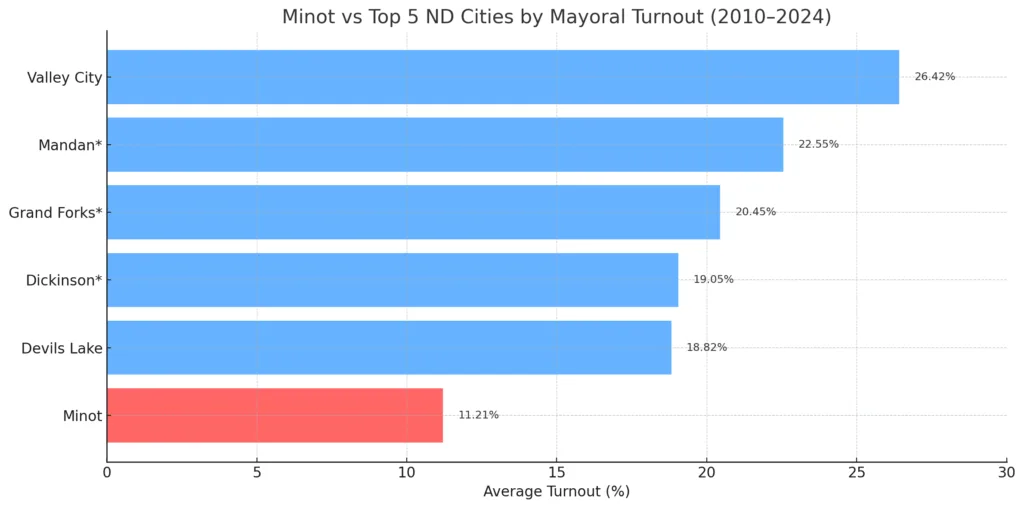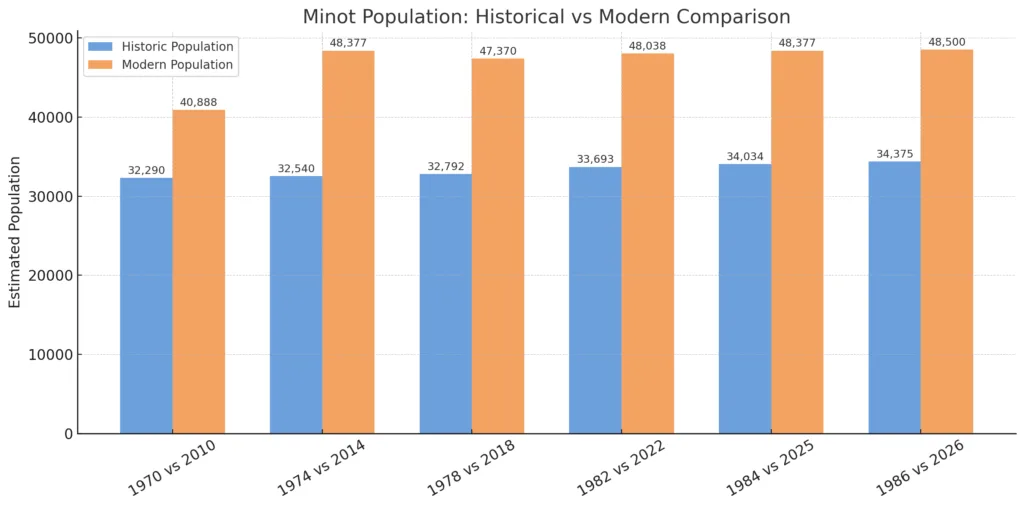

So after last weeks article breaking down statewide Mayoral election turnouts, we saw a steady recent trend for Minot's turnout numbers. Despite being the fourth largest city in the state, it is twelfth in turnout among the 13 largest cities in North Dakota. This led to a followup thought of why this might be, and if Minot has always been this apathetic to voting. When i dug into a 16 year period that is relatively similar to modern day Minot, I discovered a stark reality:

Fewer people are voting for mayor now than when the city had 15,000 fewer residents.
This article compares six historical elections from 1970 through 1986 to their modern counterparts from 2010 through 2026. I have compared total mayoral vote totals and total populations to each election year along with an estimated eligible voter number to show an accurate turnout percentage.
The timelines offer a vague parallel to each other that offers a good look at where the city has fallen short. 1970 and 2010 both come 2 years after a high profile national election that saw the U.S. in the middle of an unpopular war and had just had the party in control of the White House change hands. 1974 and 2014 both saw the re-election of the party in power 2 years prior, and they also both saw a single mayoral candidate running unopposed. 1978 and 2018 both saw high profile, multi candidate races with high turnout. 1982 and 2022 both saw tightly contested races following another massive change at the national level 2 years prior. This leaves 1984 and 2025 and 1986 and 2026, with the former dates seeing the mayor of Minot resign followed by a special election, and the latter dates were the regular election immediately following.
So, with all of that context in place, let's dive into the numbers.
Let’s look at the mayoral vote totals from the six historical elections and compare them directly to modern elections in equivalent cycles.
| Election Pair | Historic Vote Total | Modern Vote Total | Population Then | Population Now |
|---|---|---|---|---|
| 1970 vs 2010 | 6,932 | 3,220 | 32,290 | 40,888 |
| 1974 vs 2014 | 4,789 | 2,360 | 32,540 | 48,377 |
| 1978 vs 2018 | 9,902 | 6,271 | 32,792 | 47,370 |
| 1982 vs 2022 | 5,219 | 4,577 | 33,693 | 48,038 |
| 1984 vs 2025 | 5,141 | TBD | 34,034 | 47,373 |
| 1986 vs 2026 | 6,180 | TBD | 34,375 | ~48,000 |
In 1978, a competitive four-way race drew nearly 10,000 votes(Minot's highest Mayoral vote total unless 1994, 98, 02, or 06. somehow had more). In 2018, a similarly structured race in a much larger city brought just 6,271. Even an unopposed off year mid-term election like 1984 drew more voters than 2022's contested race seeing an incumbent challenged by a current and former council member.
North Dakota doesn’t require voter registration. Every resident 18 and older is eligible to vote. Using that model, we’ve retroactively applied realistic and consistent eligibility estimates across the entire 50-year span to make a fair comparison. Historical data for population under 18 is difficult to find, so I took the estimated populations and multiplied them by modern under-18 numbers to find a rough estimate. These are not perfect numbers, but they aren't far off either, and they offer another stark contrast of just how many people used to vote.
| Year | Votes Cast | Adjusted Estimated Eligible Voters | Turnout % |
|---|---|---|---|
| 1970 | 6,932 | 26,000 | 26.7% |
| 1974 | 4,789 | 26,500 | 18.1% |
| 1978 | 9,902 | 27,000 | 36.7% |
| 1982 | 5,219 | 27,500 | 19.0% |
| 1984 | 5,141 | 28,000 | 18.4% |
| 1986 | 6,180 | 28,500 | 21.7% |
| 2010 | 3,220 | 32,261 | 9.98% |
| 2014 | 2,360 | 38,008 | 6.2% |
| 2018 | 6,271 | 38,169 | 16.4% |
| 2022 | 4,577 | 37,377 | 12.2% |
This chart clearly illustrates the story: despite population growth and easy access to the ballot, turnout has dropped by more than half compared to peak levels in the 1970s. So Minot not only saw more people get out to vote, but that translated to a much higher percentage of the population, consistently having around 1/5 of the eligible voters get out and vote.
There’s no single event that explains Minot’s voter turnout collapse that I can see. It wasn’t a scandal, a law, or a change in demographics. Rather, it was a slow, quiet unraveling, the steady fading of habits, institutions, and cultural norms that once made voting for mayor feel like a shared civic necessity.
The first possible unraveling came with time itself. When Minot shifted its mayoral elections from April to June, it is possible that having lost their usual place on the calendar, it could have led to not being at the forefront of residents minds. Once a standalone event, local elections are now tucked into the margins of a primary season that most residents don't track.
At the same time, the civic nature that once propped up participation has eroded. The pages of the local paper were once the sole place to look for side-by-side profiles and election information, but that info has now massively shifted to numerous sources. Churches and civic clubs, once pillars of nonpartisan engagement, don't have near the reach they used to. None of these were dramatic changes, but they were subtle. A forum not held. A door not knocked on. A conversation not started. Over years, it has added up to silence.
And in that silence, confusion has grown. Ask someone today what the mayor of Minot actually does, and despite having a bigger role now than 40 years ago, many couldn’t tell you. The further government feels from daily life, the less reason there is to vote. And when elections come and go with minimal competition or coverage, even those who care may begin to wonder if their vote really matters.
One other possible part of the unraveling has come in the form of social culture itself. People can choose if they want to engage or not. Local races had become quieter, and candidates will typically appear on social media, if anywhere, making it much easier for people to avoid. Forums are minimally attended, when they actually happen; and even those who run for mayor often do so without the visibility or energy that might spark a sense of urgency in the community, like the changing of one old guard to another in 2014.


First, elections have to matter again. That means placing them where people will see them. One of the biggest takeaways from the statewide article was that mayoral elections on a Presidential year consistently draw more people. A move to on year elections could be a small step in the right direction, and could make local races more visible, more talked about, and more likely to feel consequential. The step beyond this that would likely be more difficult to do would be just moving the election to November to get the most possible voters out.
But timing alone isn’t enough. The community needs to feel connected to its government again. That starts in schools, where we should teach not just how government works, but how local decisions, about roads, taxes, housing, and safety are made by the people we elect in these low-turnout races. It continues in neighborhoods and events, where trusted community members/messengers (faith leaders, business owners, teachers, veterans etc.) can help re-legitimize the idea that city elections are worth showing up for.
Finally, Minot needs campaigns that ask for votes like they mean it. That doesn’t require national-scale fundraising or consultants. It requires real conversations, visible debates, and door-to-door effort. Civic trust is built when residents see candidates taking their vote seriously and showing they want to make a difference.
Turnout doesn’t collapse all at once, and it won’t recover that way either. But it can recover. And frankly it must. Because Minot is growing. Its challenges are growing. And a city that doesn’t vote for its leadership is idly sitting by and allowing more unnecessary drama and incompetence to continue run rampant.
Minot has grown. It has changed. It has adapted. But one thing has not kept pace: its political participation. In 1978, about one-third of eligible voters cast a ballot. In 2022, just 12% did. This is not an accident. It’s the result of consistent voter and civic neglect, cultural drift, and a lack of local engagement. But it truly is fixable.
The next mayor of Minot may very well be chosen by fewer than 5,000 people again unless something changes. And it can. This city has proven it can come back from far worse than voter apathy and low civic engagement.
Now it’s time for Minot to come back to the ballot box and show up to choose the next Mayor this August 5th.